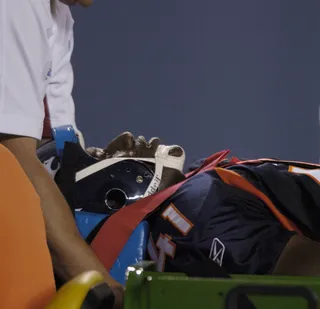CTE on the Brain
How chronic traumatic encephalopathy impacts athletes.

1 / 9
CTE in the News - In the past few weeks, four former NFL players — Mark Duper, Tony Dorsett, Joe DeLamielleure and Leonard Marshall — have said they've been diagnosed with the early stages of chronic traumatic encephalopathy, also called CTE. But what exactly is this brain disorder? Learn more about CTE and how it impacts players’ health. —Kellee Terrell(Photos from left: Stephen Dunn/ALLSPORT/Getty Images, Rick Stewart/Getty Images, George Gojkovich/Getty Images, George Rose/Getty Images)

2 / 9
What Is CTE? - Health experts believe that chronic traumatic encephalopathy, or CTE, is a degenerative and progressive disease caused from too many hits to the head. CTE may be found in football, hockey and baseball players, not to mention boxers as well. (Photo: John Lund/Getty Images/Blend Images)

3 / 9
What CTE Does to the Brain - This trauma triggers progressive degeneration of the brain tissue, including the build-up of an abnormal protein called tau, says the Boston University Center for the Study of Traumatic Encephalopathy. These changes can occur within months of being hit, years or even decades after playing the sport. (Photo: Neil Borden/Getty Images)

4 / 9
CTE Symptoms - CTE is associated with memory loss, confusion, paranoia, impaired judgment, impulse control problems, aggression, depression and progressive dementia. (Photo: Nicholas Monu/Getty Images)

5 / 9
Diagnosing CTE - Up to now, CTE could only be diagnosed via autopsy in athletes who have died. However, researchers from UCLA and Northwestern are conducting studies to diagnose the disease in its early stages while players are still alive by using brain scans, ESPN reported. (Photo: Chris Parsons/Getty Images)
ADVERTISEMENT

6 / 9
Concussions and Brain Trauma - A concussion is an injury to the brain that is caused by a severe blow to the head or body or by falling hard on the ground. Most people recover from a concussion in a matter of days, for others it might take weeks or months. It’s believed that repetitive concussions play a factor in a player developing CTE. (Photo: Karl Gehring/The Denver Post/Getty Images)
Photo By Karl Gehring/The Denver Post/Getty Images

7 / 9
The State of NFL Players’ Mental Health - Football players are also more likely to die from Alzheimer’s and Lou Gehrig’s disease (ALS) than the general population, according to the National Institute for Occupational Safety and Health (NIOSH). Quarterbacks, wide receivers and running backs account for the majority of these deaths. (Photo: ZEPHYR/SPL/Getty Images)

8 / 9
Suicide and CTE - Because one of CTE’s symptoms is depression, suicide has been a disturbing trend to this neurological disease. Junior Seau’s 2012 suicide has been blamed on CTE along with dozens of other former football players including former Chicago Bear Dave Duerson, whose family sued the NFL. (Photo: Charles Krupa, AP Photo/ File)
